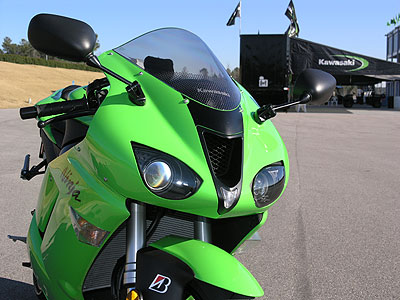2007 Kawasaki Ninja ZX-6R
Barber Motorsports Park
December 8–9, 2006
A green-eyed monster that doth mock the meat under which it feeds.
36-24-36, Only if she's 5'3"
Despite two layers of Under Armour cold gear and the front page of America’s most banal and ubiquitous daily periodical strategically placed inside my ventilated leathers, the heat left my hands the moment I touched my kangaroo skin-covered extremities to the handle bar. The rubber grips and the race gloves merely prevented my hands from instantly freezing to the aluminum of the 18 degree handlebars but did nothing to prevent every capillary between my wrists and my fingernails from snapping shut to slow the onset of hypothermia.
The air was so devoid of moisture that my exhalation could not fog my visor as it evaporated into the mercilessly bright morning. As I watched my mechanics pull the tire warmers off the Bridgestone mediums I took a minute to imagine what that front tire was going to feel like a split second after throwing the bike into turn one. I’ve seen numerous bike crashes due to cold tires with temperatures in the 80's; the thermometer at Barber Motorsports Park was currently hovering around 28 degrees F. I could clearly envision the weightless feeling the bars would have as the tire pushed out from underneath me followed by the temporary pleasure of my leathers being externally heated by their loss of potential energy. Momentarily filled with regret at my choice of wearing irreplaceable, yet sacrificial, protective gear I tried to take solace in the themes described on the back of my helmet; “’All is vanity’, ‘Memento Mori’, and sometimes you just have to suck it up and throw it in there.
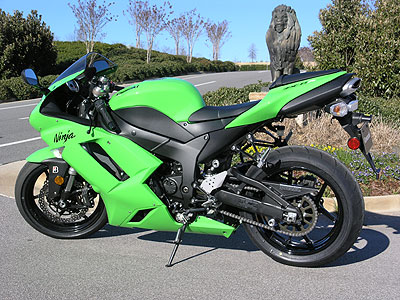
Lions are optional.
My mechanic brought the philosophic musings to an abrupt end by releasing the ZX-6 from its rear stand. The suspension oil, designed for summer temperatures, could barely squeeze its coagulated molecules through various orifices and washer stacks resulting in fork and shock movement resembling the solid suspensions of the bikes, comfortably warm, in Barber’s excellent museum less than a mile away.
To absolutely ensure that we would be faced with numerous challenges on the track we were to be led on five slow sighting laps that would guarantee that the tires lost any retained warmth from their electric blankets into the frigid macadam. I dutifully followed the leader for two laps and then, driven mad by cold, played through in an attempt to get my blood pumping a little. I made it two more laps before my hands were so far gone that I could no longer feel the brake lever. During those two laps I discovered that the tires were actually working in these artic temperatures and that the suspension was not working at all, resulting in some very strange wheel behavior.
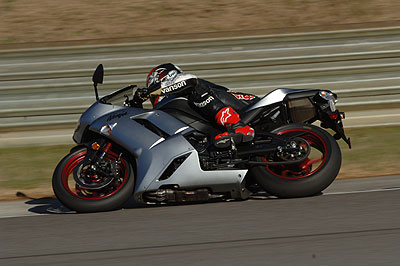
A case study in available traction at low temperatures.
My German mechanic was very concerned when I asked for the damping settings to be reduced dramatically on the bike. “But the settings were determined by our test riders and are correct” he opined. He ultimately relented and grudgingly unscrewed rebound and compression adjusters on both the forks and the shock until I could see something approximating suspension action, despite the oil having the viscosity of honey. The fact that the suspension adjusters had enough range to allow for proper settings in freezing temperatures gives testament to how far these bikes have come, and may comfort those who plan on contesting March events in Virginia.
After my insistence on radically deviating from the approved settings on the bike I felt that I would actually have to ride the thing quickly on the track. I took a lap to creep up on loading the front into turns and applying more and more throttle on the exits to determine two things: the tires were actually hanging in at these temps and the bike was accurately transmitting exactly how much grip I had to work with. When approaching the limit of the front tire the bars would lightly oscillate in my hands to let me know that it would be imprudent to go much faster while the rear would just ever-so-slightly step sideways if I coaxed it into a slide. The suspension adjustments eliminated the extraneous wheel hop resulting in a great-handling motorcycle, in 38-degree 'Bama weather.
After determining that the bike and tires were not going to unexpectedly throw me on the ground I set off in pursuit of the other journalists a greater understanding of the capacities of this all-new Kawasaki.
Three years ago Kawasaki decided that the key to middleweight market share was to perform well in magazine comparison tests. These tests are usually conducted on racetracks where the old comfy Ninja 6R felt woefully big and bulky. Of course it was probably the most appropriate bike for the street but that was hardly the point. The release of the 636 and the first generation ZX-6RR showed Kawasaki’s switch from street focus to track focus. This bike takes that new market philosophy to the logical next step.
The 2007 bike is a high-strung razor flooding the rider with feedback and reacting immediately to rider input. The rider crouch is perfectly suited to the racetrack although the pegs are ever so slightly compromised for street-riding comfort. They carve long sparking trails on the pavement with the steel pavement feelers in place and occasionally still touch down once the feelers are removed. This bike is not claimed to be particularly light but it sure feels it on the track.

Keep in mind that the track and air temperatures
were hovering in the low thirties.
Judging from the numbers this bike should have relatively high-effort steering with a strong emphasis on stability from the 25 degrees of rake and 110mm of trail. These numbers should result in a bike that turns in slowly and has a propensity to run wide, yet this bike does neither. Its agility is flirting with nervous but never crosses that line. The bike can carve, flick, double-apex and correct without undue effort or drama. The lack of steering damper means that the bars give invigorating headshakes any time the front end gets light but the bike recovers as soon as the wheel regains weight and, at least on this day, the stiff brake piston seals were able to keep the pads from being knocked back from the rotors.

If you can’t hit your apexes on this you are not going to hit them at all.
The brakes are powerful and linear and provided enough feedback to allow for some trail braking even in the frosty conditions. Kawasaki brought slipper clutches to the middleweight class. I am not sure if, all things being equal, a slipper clutch ultimately yields faster laps times but it does make a quick pace easier and safer. Drop two gears, pop out the clutch and let the bike trail into the turn with just the right amount of rear-wheel drag. My guess is that one would never notice the slipper clutch while street riding since it only really comes into play in situations with massive deceleration and many downshifts but my clumsy cold fingers were greatly appreciative of not having to modulate the clutch at the entrance to the infamous Spider Turn. After getting balked by another rider I lost track of my gears at one point and went down two when I should have gone down one. The slipper clutch makes such boneheaded moves survivable with only a bruised ego.
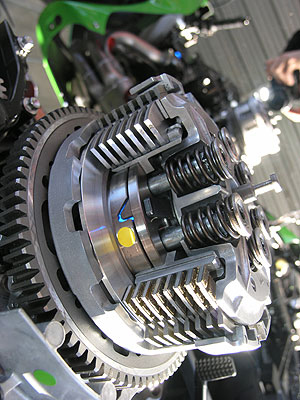
Cutaway of the slipper clutch shows the simple
and effective ramp affair.
Kawasaki has often had a somewhat tumultuous relationship with transmissions but the one tastefully designed for the 6R has every indication that the engineers got just about every detail right. The new cassette transmission has scarcely any side-to-side gear wobble and beefy shifter forks. This resulted in positive, secure and easy gear changes. The dogs on the gears are not undercut which encourages snicking clutchless speed shifts but the down side is that straight-cut dogs can be susceptible to losing their corners and then cease to engage. Of course, with the easy accessibly of the clusters changing out the 3rd-4th gear periodically is not much more complicated than changing the clutch plates. If nothing else the cassette transmission will be welcomed by legions of neophyte flat-rate mechanics assigned to the much-dreaded cases of “second gear warranty replacement”.

A boon to flat rate mechanics as well as racers.
The 6R has a generous 16,500 rpm (indicated) redline but in the American trim the rev-range above the horsepower peak of 12,500 is largely for use as an over-rev. American market bikes are delivered with a claimed 118 bhp while Europe gets a claimed 125 bhp. Surprisingly this does not have to do with exhaust emissions but with noise. Fortunately the engines themselves are identical between Europe and the USA with the noise reductions being achieved solely through software. The ECU in the USA is set to keep the tail-mounted exhaust pipe valve closed a little bit at high rpm to limit noise and the ignition curve is retarded for the US. Given the inexpensive nature of computer hardware these days Kawasaki thoughtfully left the European map in the ECU and it can be activated by shorting two wires in the ECU connectors. This connection enables the European mapping and releases the additional seven horsepower which then peak at 14,000. My German mechanic could not be prodded into installing the wire for me even under the guise of journalistic curiosity. I advise you to stay tuned to see how to de-restrict your ZX-6R as I am sure well-intentioned and well-placed individuals will shortly leak that information.
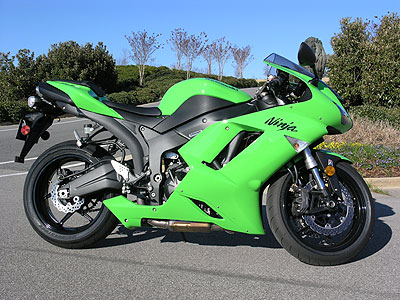
Exhaust pipe is routed through the swingarm.
The European map should remedy the only thing that saps an amount of joy from this bike. It is nimble and responsive and the engine is strong but it runs out of breath up top. It lacks a little bit of top end rush. Seven more horsepower spread over another 1500 rpm would correct that nicely.
Trackside the fuel injection was crisp and easy to use even when feeding power to the tire in high-torque, low-speed, frozen-track situations. Low speed pit cruising (which is more indicative of riding around in metropolitan context) reveals some herky-jerky fueling consistent of an emissions-cheating leanness in the fuel mixture.
Since I had just ridden the 2007 Honda CBR600RR at the same track only a week before it was impossible to not compare the two. At a moderate pace both bikes were equally competent with the Honda being a little less intimidating and easier to ride as it had a softer overall feel to it. At a fast pace the Kawasaki’s frisky nature shines through and its pure track focus rewards with nimbler handling.
That Kawasaki intended to release a street-legal race bike (street riders be damned!) is further reinforced by the model part’s catalog. Included in the catalog are alternate gear ratios for the transmission (I asked for the shorter “B” series fourth gear at the press launch but to no avail), thinner, compression-boosting (in case 13.3:1 is not high enough for you) head gaskets in a variety of thicknesses; manual cam chain tensioner; alternate camshafts (no specs available), looser bottom end bearings; alternate and presumable programmable engine control units; bigger radiators; smaller alternators; and, of course, a steering damper.

A steering damper, although not mandatory, would have calmed
the front during periods of high acceleration.
It may take a while for Kawasaki to regain a presence in the 600cc racebike grid that is so crowded with Yamahas and Suzukis but this is the product to do just that.
Many sportbikes get some major engine changes every four years; this is the first all new 600cc engine from Kawasaki in 10 years. Given the company's historic reluctance for design revisions it is not surprising that Kawasaki engineers decided to optimize the rare chance for designing an entirely new engine.
The new engine is tiny. It is compact, narrow and short and has an assortment of unique features. The first is the cassette transmission that allows easy transmission servicing as well as the ability to install alternate gear ratios. The slipper clutch remains unchanged from the 600RR because it works great just the way it is. The bore centers are very close together on this engine. That does not leave much room for heavy-breathing throttle bodies to accommodate the engine's need for air and the physical world’s need to not have overlapping solid objects.

More compact in everyway with a tasteful relocation of the oil filter
and oil cooler to the backside. That won’t make a mess when servicing.
Those oval throttle bodies are fed with air that is rammed into the nose of the fairing through the frame and into the air box. Fuel is injected through ultra-fine misting injectors that are positioned downstream of the rider-controlled butterflies. The ECU gets control over another set of butterflies in the throttle bodies to match air velocity and induction noise to the various needs of man and mankind.

Tapered oval dual butterfly throttle bodies.
The fuel mixture is fed through polished intake ports to 26.5mm intake valves (up from 24.0mm) that are packed into an extremely tight combustion chamber yielding a lofty 13.3:1 compression ratio; no regular gas for this little puppy.

Massive intake valves and a very compact combustion chamber
with a minimum of valve shrouding at partial lift.
Many of the internal components have been lightened including the pistons, wrist pins and rods although heavier flywheels have been fitted to smooth out the power delivery. Exhaust is fed into a four-into-two system with an integrated catalytic converter.

A good view of the primary catalytic converter and
muffler which reduces weight up high in the tail section.
The exhaust system has two small silencing devices, one under the center of the engine and another in the tail section. This allows engineers to put some of the weight of the exhaust system low and central instead of having all the weight of the muffler high and far back. The exhaust butterfly valve is mounted in the pipe near the tail section.

Kawasaki doesn’t even bother with the “improves low
end bhp” standard explanation for this exhaust butterfly.
The ZX-6 has its oil-to-coolant heat exchanger mounted behind the cylinders to move the weight of this component towards the center of the bike. The crank and transmission shafts have been moved into a more compact V pattern to shorten the motor and centralize the mass of the bike.

Air intake through the frame, oval throttle bodies, compact valve head,
rear mounted oil cooler and filter, cassette transmission (removed in photo),
02 sensors and pre-muffler under bike, big radiator, four pad brake calipers,
and bottom mounted fork springs.
The frame is all new with a great deal of focus placed on the balance between stiffness and flex. The basic idea is that you want a chassis that is stiff in most directions but will flex slightly when the bike is on its side to absorb small bumps that the suspension cannot. The asymmetrical swingarm is a new casting with a great deal of time invested in its stiffness-versus-flexibility balance.
The forks are 41mm inverted triple-adjustable units. Kawasaki engineers specified that the fork springs be placed in the bottom of each fork tube rather than in the traditional top of the fork tube. This arrangement is designed to completely submerge the fork springs in the oil and reduce foaming of the fork oil.
The brakes are radial-mounted calipers with a four-pads-to-four pistons arrangement that reduces brake drag, reduces the likelihood of the brake-pad warping and stabilizes wear. The brake calipers are not indexed to the fork leg so a little care is needed to make sure that they are re-installed straight with the wave style brake rotors. A radial master cylinder is used to move the fluid.
All of this is wrapped in new slippery and angular bodywork available in a four colors (Red, Black, Green and Silver) for the bargain price of $8,999.

With a color to match your
every mood, including black.

